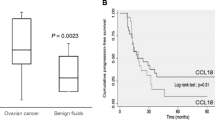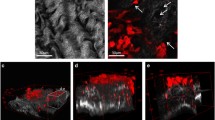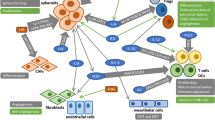Abstract
At least one-third of patients with epithelial ovarian cancer (OC) present ascites at diagnosis and almost all have ascites at recurrence. The presence of ascites, which acts as a dynamic reservoir of active molecules and cellular components, correlates with the OC peritoneal metastasis and is associated with poor prognosis. Since epithelial-mesenchymal transition (EMT) is involved in different phases of OC progression, we have investigated the effect of the unique ascitic tumor microenvironment on the EMT status and the behavior of OC cells. The exposure of three OC cell lines to ascites leads to changes in cellular morphologies. Within ascites, OC cells harboring an initial intermediate epithelial phenotype are characterized by marked dislocation of epithelial markers (E-cadherin, ZO-1 staining) while OC cells initially harboring an intermediate mesenchymal phenotype strengthen their mesenchymal markers (N-cadherin, vimentin). Ascites differentially triggers a dissemination phenotype related to the initial cell features by either allowing the proliferation and the formation of spheroids and the extension of colonies for cells that present an initial epithelial intermediate phenotype, or favoring the migration of cells with a mesenchymal intermediate phenotype. In an ascitic microenvironment, a redeployment of αv integrins into cells was observed and the ascites-induced accentuation of the two different invasive phenotypes (i.e. spheroids formation or migration) was shown to involve αv integrins. Thus, ascites induces a shift toward an unstable intermediate state of the epithelial-mesenchymal spectrum and confers a more aggressive cell behavior that takes on a different pathway based on the initial epithelial-mesenchymal cell features.






Similar content being viewed by others
Abbreviations
- Asc:
-
Ascites
- CM:
-
Culture medium
- ECM:
-
Extracellular matrix
- EMT:
-
Epithelial-mesenchymal transition
- Fn:
-
Fibronectin
- MET:
-
Mesenchymal-epithelial transition
- MMP:
-
Matrix metalloproteinases
- OC:
-
Ovarian cancer
- TIMP:
-
Tissue inhibitor of metalloproteinases
- Vn:
-
Vitronectin
References
Kipps E, Tan DSP, Kaye SB (2013) Meeting the challenge of ascites in ovarian cancer: new avenues for therapy and research. Nat Rev Cancer 13:273–282
Heyman L, Kellouche S, Fernandes J et al (2008) Vitronectin and its receptors partly mediate adhesion of ovarian cancer cells to peritoneal mesothelium in vitro. Tumour Biol 29:231–244
Burleson KM, Boente MP, Pambuccian SE et al (2006) Disaggregation and invasion of ovarian carcinoma ascites spheroids. J Transl Med 4:6
Shield K, Ackland ML, Ahmed N et al (2009) Multicellular spheroids in ovarian cancer metastases: biology and pathology. Gynecol Oncol 113:143–148
Kenny HA, Kaur S, Coussens LM et al (2008) The initial steps of ovarian cancer cell metastasis are mediated by MMP-2 cleavage of vitronectin and fibronectin. J Clin Invest 118:1367–1379
Ahmed N, Stenvers KL (2013) Getting to know ovarian cancer ascites: opportunities for targeted therapy-based translational research. Front Oncol 3:256
Ayhan A, Gultekin M, Taskiran C et al (2007) Ascites and epithelial ovarian cancers: a reappraisal with respect to different aspects. Int J Gynecol Cancer 17:68–75
Tan DSP, Agarwal R, Kaye SB (2006) Mechanisms of transcoelomic metastasis in ovarian cancer. Lancet Oncol 7:925–934
Puiffe M-L, Le Page C, Filali-Mouhim A et al (2007) Characterization of ovarian cancer ascites on cell invasion, proliferation, spheroid formation, and gene expression in an in vitro model of epithelial ovarian cancer. Neoplasia 9:820–829
Lane D, Goncharenko-Khaider N, Rancourt C et al (2010) Ovarian cancer ascites protects from TRAIL-induced cell death through alphavbeta5 integrin-mediated focal adhesion kinase and Akt activation. Oncogene 29:3519–3531
Carduner L, Agniel R, Kellouche S et al (2013) Ovarian cancer ascites-derived vitronectin and fibronectin: combined purification, molecular features and effects on cell response. Biochim Biophys Acta BBA 1830(10):4885–4897
Cruet-Hennequart S, Maubant S, Luis J et al (2003) alpha(v) integrins regulate cell proliferation through integrin-linked kinase (ILK) in ovarian cancer cells. Oncogene 22:1688–1702
Reuning U (2011) Integrin αvβ3 promotes vitronectin gene expression in human ovarian cancer cells by implicating rel transcription factors. J Cell Biochem 112:1909–1919
Leroy-Dudal J, Demeilliers C, Gallet O et al (2005) Transmigration of human ovarian adenocarcinoma cells through endothelial extracellular matrix involves alphav integrins and the participation of MMP2. Int J Cancer 114:531–543
Carreiras F, Rigot V, Cruet S et al (1999) Migration properties of the human ovarian adenocarcinoma cell line IGROV1: importance of alpha(v)beta3 integrins and vitronectin. Int J Cancer 80:285–294
Landen CN, Kim T-J, Lin YG et al (2008) Tumor-selective response to antibody-mediated targeting of alphavbeta3 integrin in ovarian cancer. Neoplasia 10:1259–1267
Davidson B, Goldberg I, Gotlieb WH et al (2003) Coordinated expression of integrin subunits, matrix metalloproteinases (MMP), angiogenic genes and Ets transcription factors in advanced-stage ovarian carcinoma: a possible activation pathway? Cancer Metastasis Rev 22:103–115
Ahmed N, Thompson EW, Quinn MA (2007) Epithelial-mesenchymal interconversions in normal ovarian surface epithelium and ovarian carcinomas: an exception to the norm. J Cell Physiol 213:581–588
Ahmed N, Abubaker K, Findlay J et al (2010) Epithelial mesenchymal transition and cancer stem cell-like phenotypes facilitate chemoresistance in recurrent ovarian cancer. Curr Cancer Drug Targets 10:268–278
Thiery JP, Acloque H, Huang RYJ et al (2009) Epithelial-mesenchymal transitions in development and disease. Cell 139:871–890
Huang RY-J, Wong MK, Tan TZ et al (2013) An EMT spectrum defines an anoikis-resistant and spheroidogenic intermediate mesenchymal state that is sensitive to e-cadherin restoration by a src-kinase inhibitor, saracatinib (AZD0530). Cell Death Dis 4:e915
López-Novoa JM, Nieto MA (2009) Inflammation and EMT: an alliance towards organ fibrosis and cancer progression. EMBO Mol Med 1:303–314
Mamuya FA, Duncan MK (2012) aV integrins and TGF-β-induced EMT: a circle of regulation. J Cell Mol Med 16:445–455
Moreno-Bueno G, Peinado H, Molina P et al (2009) The morphological and molecular features of the epithelial-to-mesenchymal transition. Nat Protoc 4:1591–1613
Zeisberg M, Neilson EG (2009) Biomarkers for epithelial-mesenchymal transitions. J Clin Invest 119:1429–1437
Shaw TJ, Senterman MK, Dawson K et al (2004) Characterization of intraperitoneal, orthotopic, and metastatic xenograft models of human ovarian cancer. Mol Ther 10:1032–1042
Bénard J, Da Silva J, De Blois MC et al (1985) Characterization of a human ovarian adenocarcinoma line, IGROV1, in tissue culture and in nude mice. Cancer Res 45:4970–4979
Hamilton TC, Young RC, McKoy WM et al (1983) Characterization of a human ovarian carcinoma cell line (NIH:OVCAR-3) with androgen and estrogen receptors. Cancer Res 43:5379–5389
Ward BG, Wallace K, Shepherd JH et al (1987) Intraperitoneal xenografts of human epithelial ovarian cancer in nude mice. Cancer Res 47:2662–2667
Staack A, Badendieck S, Schnorr D et al (2006) Combined determination of plasma MMP2, MMP9, and TIMP1 improves the non-invasive detection of transitional cell carcinoma of the bladder. BMC Urol 6:19
Roskelley CD, Bissell MJ (2002) The dominance of the microenvironment in breast and ovarian cancer. Semin Cancer Biol 12:97–104
Villedieu M, Briand M, Duval M et al (2007) Anticancer and chemosensitizing effects of 2,3-DCPE in ovarian carcinoma cell lines: link with ERK activation and modulation of p21WAF1/CIP1, Bcl-2 and Bcl-xL expression. Gynecol Oncol 105:373–384
Ahmed N, Riley C, Oliva K et al (2005) Ascites induces modulation of alpha6beta1 integrin and urokinase plasminogen activator receptor expression and associated functions in ovarian carcinoma. Br J Cancer 92:1475–1485
Lee S, Yang Y, Fishman D et al (2013) Epithelial-mesenchymal transition enhances nanoscale actin filament dynamics of ovarian cancer cells. J Phys Chem B 117:9233–9240
Davidson B, Tropé CG, Reich R (2012) Epithelial-mesenchymal transition in ovarian carcinoma. Front Oncol 2:33
Auersperg N, Wong AS, Choi KC et al (2001) Ovarian surface epithelium: biology, endocrinology, and pathology. Endocr Rev 22:255–288
Hudson LG, Zeineldin R, Stack MS (2008) Phenotypic plasticity of neoplastic ovarian epithelium: unique cadherin profiles in tumor progression. Clin Exp Metastasis 25:643–655
Quattrocchi L, Green AR, Martin S et al (2011) The cadherin switch in ovarian high-grade serous carcinoma is associated with disease progression. Virchows Arch 459:21–29
Sivertsen S, Berner A, Michael CW et al (2006) Cadherin expression in ovarian carcinoma and malignant mesothelioma cell effusions. Acta Cytol 50:603–607
Comamala M, Pinard M, Thériault C et al (2011) Downregulation of cell surface CA125/MUC16 induces epithelial-to-mesenchymal transition and restores EGFR signalling in NIH:OVCAR3 ovarian carcinoma cells. Br J Cancer 104:989–999
Ponnusamy MP, Lakshmanan I, Jain M et al (2010) MUC4 mucin-induced epithelial to mesenchymal transition: a novel mechanism for metastasis of human ovarian cancer cells. Oncogene 29:5741–5754
Latifi A, Luwor RB, Bilandzic M et al (2012) Isolation and characterization of tumor cells from the ascites of ovarian cancer patients: molecular phenotype of chemoresistant ovarian tumors. PLoS ONE 7:e46858
Wintzell M, Hjerpe E, Åvall Lundqvist E, Shoshan M (2012) Protein markers of cancer-associated fibroblasts and tumor-initiating cells reveal subpopulations in freshly isolated ovarian cancer ascites. BMC Cancer 12:359
Thibault B, Castells M, Delord JP, Couderc B (2013) Ovarian cancer microenvironment: implications for cancer dissemination and chemoresistance acquisition. Cancer Metastasis Rev. doi:10.1007/s10555-013-9456-2
Hanahan D, Coussens LM (2012) Accessories to the crime: functions of cells recruited to the tumor microenvironment. Cancer Cell 21(3):09–322
Carduner L, Picot CR, Leroy-Dudal J et al (2013) Cell cycle arrest or survival signaling through αv integrins and activation of PKC and ERK1/2 lead to anoikis resistance of ovarian cancer spheroids. Exp Cell Res 320(2):329–342
Pease JC, Brewer M, Tirnauer JS (2012) Spontaneous spheroid budding from monolayers: a potential contribution to ovarian cancer dissemination. Biol Open 1:622–628
Makhija S, Sabbatini P, Barakat RR (1999) Intraperitoneal chemotherapy strategies in the treatment of epithelial ovarian carcinoma. Curr Opin Obstet Gynecol 11:23–27
Veatch AL, Carson LF, Ramakrishnan S (1994) Differential expression of the cell–cell adhesion molecule E-cadherin in ascites and solid human ovarian tumor cells. Int J Cancer 58:393–399
Rosanò L, Spinella F, Di Castro V et al (2005) Endothelin-1 promotes epithelial-to-mesenchymal transition in human ovarian cancer cells. Cancer Res 65:11649–11657
Kellouche S, Fernandes J, Leroy-Dudal J et al (2010) Initial formation of IGROV1 ovarian cancer multicellular aggregates involves vitronectin. Tumour Biol 31:129–139
Uhm JH, Dooley NP, Kyritsis AP et al (1999) Vitronectin, a glioma-derived extracellular matrix protein, protects tumor cells from apoptotic death. Clin Cancer Res 5:1587–1594
Xing H, Weng D, Chen G et al (2008) Activation of fibronectin/PI-3 K/Akt2 leads to chemoresistance to docetaxel by regulating survivin protein expression in ovarian and breast cancer cells. Cancer Lett 261:108–119
Matte I, Lane D, Laplante C et al (2012) Profiling of cytokines in human epithelial ovarian cancer ascites. Am J Cancer Res 2:566–580
Valdembri D, Serini G (2012) Regulation of adhesion site dynamics by integrin traffic. Curr Opin Cell Biol 24:582–591
Acknowledgments
This work was supported by the Ligue Contre le Cancer comité du Val d’Oise, France. L. Carduner is a recipient of a fellowship from the Ministère de l’Enseignement Supérieur et de la Recherche, and of the Université de Cergy-Pontoise. The authors thank Dr. C. Blanc-Fournier and M. Briand from F. Baclesse comprehensive center for their support in obtaining ascites samples. We thank Dr. L. Poulain, Dr. C. Denoyelle and Pr. P. Gauduchon (BioTICLA unit from F. Baclesse comprehensive center) for their constant support and advice. We thank Dr. S. Sin (Biology Development lab) for providing some of EMT marker antibodies. The manuscript was revised by Biomedes for English language editing.
Conflict of interest
The authors declare that they have no conflict of interest.
Author information
Authors and Affiliations
Corresponding author
Rights and permissions
About this article
Cite this article
Carduner, L., Leroy-Dudal, J., Picot, C.R. et al. Ascites-induced shift along epithelial-mesenchymal spectrum in ovarian cancer cells: enhancement of their invasive behavior partly dependant on αv integrins. Clin Exp Metastasis 31, 675–688 (2014). https://doi.org/10.1007/s10585-014-9658-1
Received:
Accepted:
Published:
Issue Date:
DOI: https://doi.org/10.1007/s10585-014-9658-1




